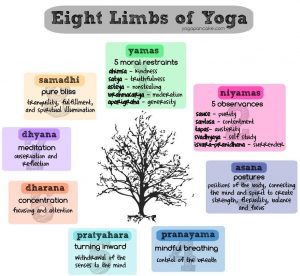Yoga Nidra meditation is a simple yet profound technique adapted by Swami Satyananda Saraswati from the traditional tantric esoteric traditions rooted in Hindu and Buddhist philosophy) and the practices of pratyahara (withdrawal of senses) and mental nyasa rituals (‘place’ efforts of relaxation on specific parts of the body).
Yoga nidra was experienced by Satyananda Saraswati when he was living with his guru Sivananda Saraswati in Rishikesh. He began studying the tantric scriptures and, after practice, constructed a system of relaxation, which he began popularising in the mid-20th century.
 He explained yoga nidra as a state of mind between wakefulness and sleep that opened deep phases of the mind, suggesting a connection with the ancient tantric practice called nyasa, whereby Sanskrit mantras are mentally placed within specific body parts, while meditating on each part (of the bodymind). The form of practice taught by Satyananda includes eight stages (internalisation, sankalpa, rotation of consciousness, breath awareness, manifestation of opposites, creative visualisation, sankalpa and externalisation).
He explained yoga nidra as a state of mind between wakefulness and sleep that opened deep phases of the mind, suggesting a connection with the ancient tantric practice called nyasa, whereby Sanskrit mantras are mentally placed within specific body parts, while meditating on each part (of the bodymind). The form of practice taught by Satyananda includes eight stages (internalisation, sankalpa, rotation of consciousness, breath awareness, manifestation of opposites, creative visualisation, sankalpa and externalisation).
This state of consciousness (yoga nidra) is different from meditation in which concentration on a single focus is required. In yoga nidra the practitioner remains in a state of light withdrawal of the 5 senses (pratyahara) with four of his or her senses internalised, that is, withdrawn, and only the hearing still connects to the instructions. The yogic goal of both paths, deep relaxation (yoga nidra) and meditation are the same, a state of meditative consciousness called Samadhi.
 As well as being relaxing, restorative and restful, studies have shown that yoga nidra can also:
As well as being relaxing, restorative and restful, studies have shown that yoga nidra can also:
• Ease insomnia
• Decrease chronic pain
• Reduce PTSD
• Heighten awareness and focus
• Transform negative habits and behaviours
• Foster feelings of peace, calm, and clarity
Tantras refers to numerous and varied scriptures pertaining to any of several esoteric traditions rooted in Hindu and Buddhist philosophy. The religious culture of the Tantras is essentially Hindu, and Buddhist Tantric material can be shown to have been derived from Hindu sources, and although Hindu and Buddhist Tantra have many similarities from the outside, they do have some clear distinctions.
 Pratyahara or the ‘withdrawal of the senses’ is the fifth element among the Eight stages of Patanjali’s Ashtanga Yoga, as mentioned in his classical work, Yoga Sutras of Patanjali composed in the 2nd century BCE. It is also the first stage of the six-branch yoga (ṣaḍaṅgayoga) of the Buddhist Kālacakra tantra.
Pratyahara or the ‘withdrawal of the senses’ is the fifth element among the Eight stages of Patanjali’s Ashtanga Yoga, as mentioned in his classical work, Yoga Sutras of Patanjali composed in the 2nd century BCE. It is also the first stage of the six-branch yoga (ṣaḍaṅgayoga) of the Buddhist Kālacakra tantra.
In Hinduism, nyasa is a Tantric ritual that involves a series of touches in specific locations on the body. This is done by a “seer,” or rishi, who chants a specific mantra to “place” it on a body part. It is thought that this ritual imparts the presence of a deity in the body or makes the body of the individual more divine. In Sanksrit, nyasa means “placing” or “touching.”

